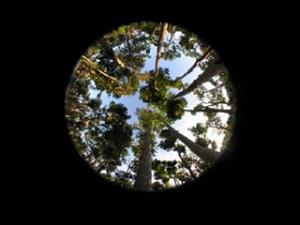Shimona Quazi
The aim of the project is to compare biodiversity in two common types of managed forests found in and near nature reserves in upland Bangladesh: traditional agroforests and monoculture plantations. I aim to find out which forest type is more similar to natural secondary forest, and identify management modifications that can benefit both habitat conservation and local people’s livelihoods.

Betel leaf agroforestry.
Nature conservation areas are increasing in number worldwide, but new reserves in low-income countries are often fragmented, small, and poorly managed. Intensive human land-use practices such as agriculture, mining and grazing may surround these reserves. Land uses that contrast strongly with wildlife habitat can negatively impact species, reducing the effective size of the conservation area. To counter this, a growing body of academic research focuses on extending conservation functions beyond the boundaries of protected areas to the working lands around them. This involves identifying appropriate human activities for landscapes around nature reserves that can enhance biodiversity without harming local livelihoods, especially in poor rural areas. Managed forests resembling natural forests maintain more biodiversity than monoculture timber plantations and non-forest land use, and so mixed-tree systems such as agroforestry have recently drawn attention for their potential to improve biodiversity in forested landscapes.

Canopy hemiphoto in agroforest.
In north-eastern Bangladesh, protected forests are small, fragmented and embedded in a human-dominated matrix of tea and annual cash crops, with no buffer zones between forest and fields. One ethnic group in this area practices a traditional agroforestry system that uses a diverse mixture of species and is their only source of income. Although the system is profitable and may have conservation value, academics and government foresters in Bangladesh claim that it destroys forest resources, preferring monoculture plantations of timber species such as teak for revenue generation. No quantitative data exists to verify the effects of either practice on biodiversity, so any threats to conservation efforts remain unidentified. I address this knowledge gap by comparing the two types of managed forest, agroforestry and teak plantations, to naturally occurring secondary forests in the parks and reserve forests of the area. Using a wide suite of biotic and abiotic parameters, I assess these vegetation types for their conservation value. My results will be used to prepare evidence-based recommendations with the local people and the Forest Department to improve forest management practices in the national parks. This information is vital for landscapes where remaining natural habitats are isolated fragments surrounded by intensive human use. Human uses are dramatically changing landscapes and species compositions worldwide. Agroforestry and plantation forestry are the economic base for millions of people. Sustainable resource management in the tropics depends on effectively aligning such forestry practices with species conservation goals. By testing if agroforestry can minimize the negative impacts of land-use change on biodiversity, this study will provide informative lessons for South Asia and beyond.